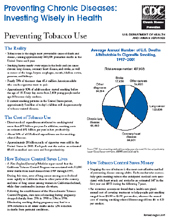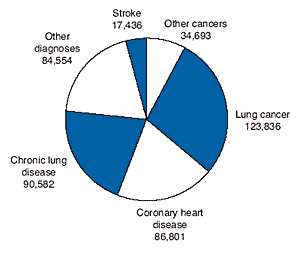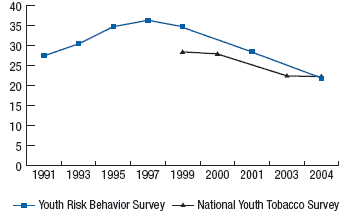 |
|
 |
 |
 |
 |
Preventing Chronic Disease: Investing Wisely in Health
Revised August 2005

Preventing Tobacco Use (PDF–127K)
Learn more about
PDFs. |
|
|
|
Preventing Tobacco Use
The Reality
- Tobacco use is the single most preventable cause of death and
disease, causing approximately 440,000 premature deaths in the United
States each year.1
- Smoking harms nearly every organ in the body and can cause chronic
lung disease, coronary heart disease, and stroke, as well as cancer of
the lungs, larynx, esophagus, mouth, bladder, cervix, pancreas, and
kidneys.2
- Nearly 70% of the more than 45.4 million American adults who smoke
cigarettes want to quit. 3,4
- Approximately 80% of adult smokers started smoking before the age of
18. Every day, more than 2,000 young people under age 18 become daily
smokers. 5,6
- If current smoking patterns in the United States persist,
approximately 5 million of today’s children will die prematurely of
tobacco-related diseases.7
The Cost of Tobacco Use
- Direct medical expenditures attributed to smoking total more than
$75 billion per year. In addition, smoking costs an estimated $92
billion per year in lost productivity. 1,8
- About 14% of all Medicaid expenditures are for smoking-related
illnesses. 8
- Approximately 20 billion packs of cigarettes were sold in the United
States in 2002. Each pack cost the nation an estimated $8.61 in medical
care costs and lost productivity.9
How Tobacco Control Saves Lives
- A New England Journal of Medicine report noted that the California
Tobacco Control Program was associated with 33,000 fewer deaths from
heart disease from 1989 through 1997. 10 During this time, rates of lung
cancer among men declined more rapidly in California than in other parts
of the country, and rates of lung cancer among women in California
declined, while they continued to increase elsewhere. 11
- Following the establishment of the Massachusetts Tobacco Control
Program, state rates of smoking during pregnancy dropped sharply, from
25% in 1990 to 13% in 1996. 12 Eliminating smoking during pregnancy may
lead to a 10% reduction in all infant deaths and a 12% reduction in
deaths from perinatal conditions.13
Average
Annual Number of U.S. Deaths Attributable to Cigarette Smoking, 1997–2001
(Total average number: 437,902)

Source: CDC. Annual smoking-attributable mortality,
years of potential life lost, and productivity losses—United
States—1997–2001. MMWR 2005;54(25):625–8.
(A text
version of this graphic is also available.)
How Tobacco
Control Saves Money
- Stopping the use of tobacco is the most cost-effective method of
preventing disease among adults.14 Each smoker who successfully quits
smoking reduces the anticipated medical costs associated with heart
attack and stroke by an estimated $47 in the first year and $853 during
the following 7 years.15
- An economic assessment found that a health care plan’s annual cost
of covering treatment to help people quit smoking ranged from $0.89 to
$4.92 per smoker, whereas the annual cost of treating smoking-related
illness ranged from $6 to $33 per smoker.16
Effective Strategies
- CDC’s Best Practices for Comprehensive Tobacco Control Programs,
based on effective strategies from states with comprehensive approaches,
provides guidelines and funding estimates to help states establish
highly effective tobacco control programs. 17
- These guidelines are further supported by the independent Task Force
on Community Preventive Services, which strongly recommends increasing
the price of tobacco products, conducting mass media campaigns,
developing multi-component cessation interventions, reducing
out-of-pocket costs for treatment, and instituting smoking bans and
restrictions to reduce exposure to environmental tobacco smoke in public
places. 18
- Funding comprehensive programs—as Arizona, California, Florida,
Massachusetts, Oregon, and Washington have demonstrated— produces
measurable progress toward meeting statewide tobacco control objectives,
including declines in adult and youth smoking and per capita cigarette
consumption, as well as declines in rates of exposure to secondhand
smoke.
- The more states spend on comprehensive tobacco control programs, the
greater the reductions in smoking. And the longer states invest in such
programs, the greater and faster the impact.19
Hope for the Future
A mere 8% of the total available annual income from tobacco excise
taxes and tobacco settlement payments would allow all state programs to be
funded at CDC’s minimum recommended level. 20 If states spent the minimum
amount recommended by CDC on tobacco prevention and control, youth smoking
rates would be reduced by an estimated 3% to 13.5%.21
Percentage of High School Students Who Currently
Smoke Cigarettes,* United States, 1991–2004

*Smoking one or more cigarettes during the previous 30
days.
Sources: CDC. Cigarette use among high school
students—United States, 1991–2003. MMWR 2004;53(23):499–502. CDC.
Youth tobacco surveillance—United States, 1998–1999. MMWR
2000;49(SS-10):1–94. CDC. Youth tobacco surveillance—United States, 2000.
MMWR 2001;50(SS-04):1–84. CDC. Tobacco use access and exposure to
tobacco in media among middle and high school students—United States,
2004. MMWR 2005;54(12):297–301.
(A text
version of this graphic is also available.)
State
Programs in Action: Colorado
 Colorado Voters Step in to Strengthen Funding, Secure a Future
for the State Tobacco Control Program Colorado Voters Step in to Strengthen Funding, Secure a Future
for the State Tobacco Control Program
In 2002, Colorado had a well-established tobacco control program
that received $15 million in funding from state settlement funds as
well as federal and nongovernmental support. However, in 2003 and
again in 2004, the Colorado legislature drastically reduced tobacco
settlement funds for the State Tobacco Education and Prevention
Partnership. By 2004, Colorado was spending far below the minimum
funding level recommended by CDC.
These funding cuts prompted various partners concerned about the
health of Colorado citizens to come together and conduct a campaign
to educate the public and tobacco use and the need to increase
funding for tobacco prevention and control. The campaign was a
success. In 2004, voters passed an excise tax increase of 64 cents
per pack of cigarettes—from 20 cents, one of the lowest tax rates in
the country, to 84 cents. Voters also approved an increase in taxes
on other tobacco products—from 20% of the manufacturer’s list price
to 40%.
 The
tax revenues, all earmarked for health initiatives, now include 16% of
expected revenue to support chronic disease programs that will address
cancer, heart disease, and lung diseases; 16% for tobacco prevention and
treatment; 46% for the expansion of Medicaid and the Children’s Health
Insurance Program, 19% for Community Health Centers, and 3% to bolster the
Old Age Pension Fund. The
tax revenues, all earmarked for health initiatives, now include 16% of
expected revenue to support chronic disease programs that will address
cancer, heart disease, and lung diseases; 16% for tobacco prevention and
treatment; 46% for the expansion of Medicaid and the Children’s Health
Insurance Program, 19% for Community Health Centers, and 3% to bolster the
Old Age Pension Fund.
This support brings Colorado to the CDC-recommended minimum
funding level for its comprehensive tobacco control program. Also,
because the tax increase and use of the funds have been incorporated
into the Colorado Constitution, funds cannot be reallocated without
a vote of the people. |
Supporting References
- CDC. Annual smoking-attributable mortality, years of potential life
lost, and productivity losses—United States, 1997–2001. MMWR
2005; 54(25):625–628.
- U.S. Department of Health and Human Services. The Health
Consequences of Smoking: A Report of the Surgeon General. Atlanta,
Georgia: U.S. Department of Health and Human Services, Centers for
Disease Control and Prevention, National Center for Chronic Disease
Prevention and Health Promotion, Office on Smoking and Health, 2004.
- CDC. Cigarette smoking among adults—United States, 2000. MMWR
2002; 51(29):642–645.
- CDC. Cigarette smoking among adults—United States, 2003. MMWR
2005; 54(20):509–513.
- U.S. Department of Health and Human Services. Preventing Tobacco Use
Among Young People: A Report of the Surgeon General. Atlanta, Georgia:
U.S. Department of Health and Human Services, Public Health Service,
Centers for Disease Control and Prevention, National Center for Chronic
Disease Prevention and Health Promotion, Office on Smoking and Health,
1994.
- SAMHSA. 2003 National Survey on Drug Use and Health. Table 4.18A,
Numbers (in thousands) of persons who began daily cigarette use in the
United States, their mean age at first use, and rates of first use (per
1,000 person-years of exposure): 1965–2002, based on 2002 and 2003
NSDUHs. Available at
http://www.oas.samhsa.gov/nhsda/2k3tabs/Sect4peTabs1to60.htm.
- CDC. Incidence of initiation of cigarette smoking—United States,
1965-1996. MMWR 1998; 47(39):837–40.
- CDC. Annual smoking-attributable mortality, years of potential life
lost, and economic costs—United States, 1995–1999. MMWR 2002;
51(14):300–3.
- CDC. Sustaining State Programs for Tobacco Control: Data Highlights
2004. Atlanta, Georgia: Centers for Disease Control and Prevention,
National Center for Chronic Disease Prevention and Health Promotion,
Office on Smoking and Health, 2004.
- Fitchtenburg CM, Glantz SA. Association of the California Tobacco
Control Program with declines in cigarette consumption and mortality
from heart disease. New England Journal of Medicine
2000;343(24):1772–1777.
- CDC. Declines in lung cancer rates—California, 1988–1997. MMWR
2000; 49(47):1066–1069.
- Mathews TJ. Smoking during pregnancy, 1990–96. National Vital
Statistics Reports 1998;47(10).
- U.S. Department of Health and Human Services. Women and Smoking: A
Report of the Surgeon General. Atlanta, Georgia: U.S. Department of
Health and Human Services, Public Health Service, Centers for Disease
Control and Prevention, National Center for Chronic Disease Prevention
and Health Promotion, Office on Smoking and Health, 2001.
- Eddy DM. David Eddy ranks the tests. Harvard Health Letter
1992;17(9):10–11.
- Lightwood JM, Glantz SA. Short-term economic and health benefits of
smoking cessation. Circulation 1997;96(4):1089–1096.
- Curry SJ, Grothaus LC, McAfee T, Pabiniak C. Use and cost
effectiveness of smoking-cessation services under four insurance plans
in a health maintenance organization. New England Journal of Medicine
1998;339(10):673–679.
- CDC. Best Practices for Comprehensive Tobacco Control Programs –
August 1999. Atlanta, Georgia: U.S. Department of Health and Human
Services, Centers for Disease Control and Prevention, National Center
for Chronic Disease Prevention and Health Promotion, Office on Smoking
and Health, August 1999.
- Task Force on Community Preventive Services. Recommendations
regarding interventions to reduce tobacco use and exposure to
environmental tobacco smoke. American Journal of Preventive Medicine
2001;20(2S):10–15.
- Farrelly MC, Pechacek TF, Chaloupka FJ. The impact of tobacco
control program expenditures on aggregate cigarette sales: 1981–2000.
Journal of Health Economics 2003; 22(5):843–859.
- Campaign for Tobacco-Free Kids, American Heart
Association, American Cancer Society, American Lung Association. A
broken promise to our children: the 1998 Master Settlement Agreement 6
years later. December 2004.
- Tauras JA, Chaloupka FJ, Farrelly MC, et al. State tobacco control
spending and youth smoking. American Journal of Public Health
2005;95(2):338–44.
* Links to non-Federal
organizations are provided solely as a service to our users. Links do not
constitute an endorsement of any organization by CDC or the Federal
Government, and none should be inferred. The CDC is not responsible for
the content of the individual organization Web pages found at this link.
For more information and references supporting these facts, visit
www.cdc.gov/nccdphp. For
additional copies of this document, E-mail
cdcinfo@cdc.gov.
Department of
Health and Human Services
Centers for Disease Control and Prevention |
 |
Page last reviewed: November 25, 2005
Page last modified: November 25, 2005
Content source: National Center for
Chronic Disease Prevention and Health Promotion
|
 |